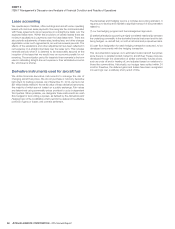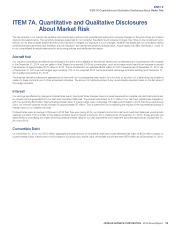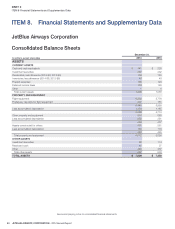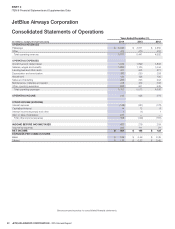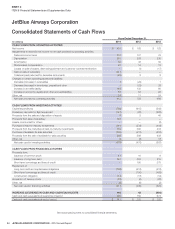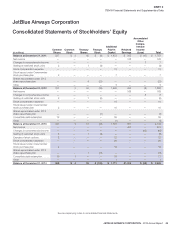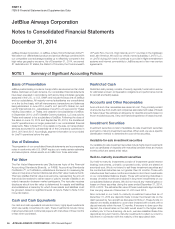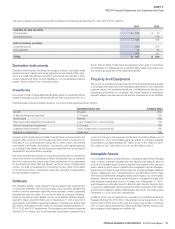JetBlue Airlines 2014 Annual Report Download - page 54
Download and view the complete annual report
Please find page 54 of the 2014 JetBlue Airlines annual report below. You can navigate through the pages in the report by either clicking on the pages listed below, or by using the keyword search tool below to find specific information within the annual report.JETBLUE AIRWAYS CORPORATION-2014Annual Report48
PART II
ITEM 8Financial Statements and Supplementary Data
Passenger Revenue
Passenger revenue is recognized when the transportation is provided or
after the ticket or customer credit issued upon payment of a change fee
expires. It is recognized net of the taxes that we are required to collect
from our customers, including federal transportation taxes, security taxes
and airport facility charges. Tickets sold but not yet recognized as revenue
and unexpired credits are included in air traffic liability.
Loyalty Program
We account for our customer loyalty program, TrueBlue
®
, by recording a
liability for the estimated incremental cost of outstanding points earned
from JetBlue purchases that we expect to be redeemed. The estimated
cost includes incremental fuel, insurance, passenger food and supplies
and reservation costs. We adjust this liability, which is included in air traffic
liability, based on points earned and redeemed, points that will ultimately
go unused, or breakage, changes in the estimated incremental costs
associated with providing travel and changes in the TrueBlue® program.
This liability was $24 million and $19 million as of December 31, 2014
and 2013, respectively. We estimate breakage based on historical point
redemptions. In June 2013, we amended the program so points earned
by members never expire. As a result of this change, our estimate for the
breakage decreased resulting in a $5 million reduction in revenue and a
corresponding increase in air traffic liability in 2013. In October 2013, we
introduced the pooling of points between small groups of people, branded
as Family Pooling™. We believe Family Pooling™ has not had a material
impact on the breakage calculation at year-end. We did not make any
changes to our frequent flyer accounting in 2014.
Points in TrueBlue
®
can also be sold to participating companies, including
credit card and car rental companies. These sales are accounted for as
multiple-element arrangements, with one element representing the fair
value of the travel that will ultimately be provided when the points are
redeemed and the other consisting of marketing related activities that we
conduct with the participating company. The fair value of the transportation
portion of these point sales is deferred and recognized as passenger
revenue when transportation is provided. The marketing portion, which
is the excess of the total sales proceeds over the estimated fair value of
the transportation to be provided, is recognized in other revenue when
the points are sold. TrueBlue
®
points sold to participating companies
which are not redeemed are recognized as revenue when management
determines the probability of redemption is remote. Deferred revenue
was $162 million and $131million at December 31, 2014 and 2013,
respectively. We recorded no revenue related to point expirations during
2014 and $2 million, and $5 million during 2013 and 2012, respectively.
Upon the re-launch of the TrueBlue
®
program in November 2009, we
extended our co-branded credit card and membership rewards participation
agreements. In connection with these extensions, we received a one-time
payment of $37 million, which we deferred and are recognizing as other
revenue over the term of the agreement through 2015. We recognized
approximately $7 million of revenue related to this one-time payment
during 2014, 2013 and 2012, respectively. In connection with exclusive
benefits to be introduced for our co-branded credit card, we received a
one-time payment of $6 million during 2012, which we have deferred and
will recognize as other revenue over the remaining term of the agreement.
For the year ended December 31, 2014, we have recorded $1 million of
revenue related to this one-time payment.
LiveTV Commercial Agreements
LiveTV provides in-flight entertainment solutions for various commercial
airlines. These solutions include equipment and related installation as well
as agreements for ongoing service and support. In June 2014, we sold
LiveTV and until this time we accounted for the equipment agreements
as operating leases, with related revenue recognized ratably over the
term of the related customer agreement in accordance with the Revenue
Recognition-Multiple-Element Arrangements topic of the Codification. This
determination was principally as a result of the long term nature of these
agreements and the resulting uncertainties surrounding the total costs
to provide ongoing equipment maintenance and upkeep throughout the
contractual term. We accounted for payments for ongoing service and
support ratably over the term of the related customer contract. Before
the sale of LiveTV, customer advances that were to be applied in the next
12 months were included in other current liabilities on our consolidated
balance sheets while those beyond 12 months were included in other
liabilities. As of December 31, 2014, no LiveTV balances are included in
our consolidated balance sheets.
Airframe and Engine Maintenance and Repair
Regular airframe maintenance for owned and leased flight equipment is
charged to expense as incurred unless covered by a third-party long-term
flight hours service agreement. We have separate service agreements in
place covering scheduled and unscheduled repairs of certain airframe line
replacement unit components as well as the engines in our fleet. These
agreements, whose original terms generally range from ten to 15 years,
require monthly payments at rates based either on the number of cycles
each aircraft was operated during each month or the number of flight
hours each engine was operated during each month, subject to annual
escalations. These power by the hour agreements transfer certain risks,
including cost risks, to the third-party service providers. They generally
fix the amount we pay per flight hour or number of cycles in exchange for
maintenance and repairs under a predefined maintenance program, which
are representative of the time and materials that would be consumed.
These costs are expensed as the related flight hours or cycles are incurred.
One of our maintenance providers is a subsidiary of a large shareholder
of ours and is a related party. We recorded approximately $20 million in
2014, $19 million in 2013 and $7 million in 2012 in maintenance expense
provided by this related party.
Advertising Costs
Advertising costs, which are included in sales and marketing, are expensed
as incurred. Advertising expense was $64 million in 2014, $61 million in
2013 and $57 million in 2012.
Share-Based Compensation
We record compensation expense for share-based awards based on the
grant date fair value of those awards. Share-based compensation expense
includes an estimate for pre-vesting forfeitures and is recognized over the
requisite service periods of the awards on a straight-line basis.
Income Taxes
We account for income taxes utilizing the liability method. Deferred income
taxes are recognized for the tax consequences of temporary differences
between the tax and financial statement reporting bases of assets and
liabilities. A valuation allowance for deferred tax assets is provided unless
realizability is judged by us to be more likely than not. Our policy is to
recognize interest and penalties accrued on any unrecognized tax benefits
as a component of income tax expense.


